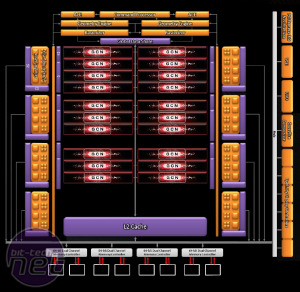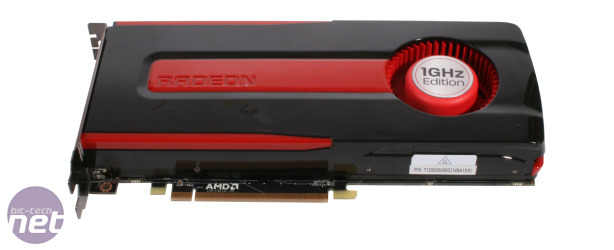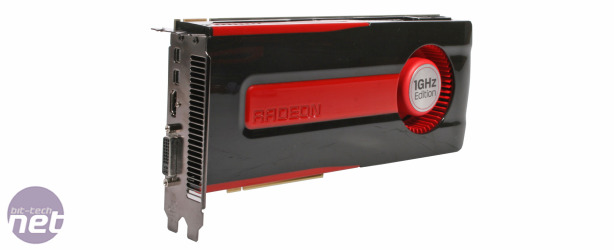
AMD Radeon HD 7870 2GB Review
Manufacturer: AMDUK Price (as reviewed): TBC (estimated £275 inc VAT) Release date March 19th
US Price (as reviewed): TBC (estimated $349 ex. tax) Release date March 19th
While AMD should be lauded for being first to market with 28nm GPUs, we’re still a little confused by AMD’s 7-series product line-up. With the 7970 3GB portioned off into its own ‘super-high end’ £450 bracket and the HD 7950 3GB hitting at around £350, the arrival of the HD 7770 1GB at £130 left a rather large £220 hole for the new 7800 series cards to fill. With today’s arrival of the HD 7870 2GB and HD 7850 2GB, we’re coming closer to completing the picture, and of the two, it’s the HD 7870 2GB that’s the most intriguing.
While still based on the same Southern Islands architecture as the HD 7970’s Tahiti XT and HD 7770 1GB’s Cape Verde GPUs, the HD 7800 series carries a third class, dubbed Pitcairn. This middle-child of the family squeezes 2.8 billion transistors onto a 212mm² die, but bares more in common with the high end Tahiti chips than the massively reduced GPUs of the 7700 family.


Click to enlarge - The Pitcairn XT GPU offers fewer compute units than the HD 7900 series, but an untouched dual front-end and full complement of 32 ROPs
Critically, Pitcairn retains the dual front-end layout of Tahiti, with a pair of geometry engines combining a geometry assembler, vertex assembler and ninth generation tesselator. It also retains the full complement of eight render back-end units, each with four ROPs, for a combined total of 32 ROPs.
There have had to be some reductions though, most notably when it comes to memory. Four 64-bit dual-channel memory controllers make for a 256-bit memory interface rather than the 384-bit of the 79xx series, with 2GB of GDDR5 replacing the 3GB of the higher end cards. This is still more than enough for gaming at high single-panel resolutions such as 2,560 x 1,600 though. The memory itself runs at a frequency of 1,200MHz (4,800MHz effective, for a peak memory bandwidth of 153.6GB/sec.
While the dual front-end interface and memory controller are common to both Pitcairn GPUs, the Pitcairn XT of the HD 7870 2GB is the better equipped. While the stream processor count has also been reduced in comparison to the 79xx cards, its nowhere near the extent of the HD 7700 series. The HD 7870 2GB boasts 20 compute units (dubbed GCNs on the block-diagram) each containing four SIMDs of 16 stream processors. The result is a total of 1,280 stream processors, just below 2/3 of the HD 7970 3GB.
While it might sport fewer stream processors, AMD has made up for this by setting the HD 7870 2GB’s stock core frequency at a mighty 1GHz, gaining it entry into AMD’s ‘GHz Edition’ club. This bridges the gap to the HD 7870 and HD 7950 3GB quite considerably; the 7950 3GB offers eight more compute units (512 more stream processors), but at a lower 800MHz core frequency. As both cards share the same dual front-end design, AMD has told us that this actually makes the HD 7870 2GB faster under heavy tessellation work-loads than the HD 7950 3GB.
In almost every way then, the HD 7870 2GB’s Pitcairn XT GPU offers double the resources of the HD 7770 1GB’s Cape Verde XT. Twice the front end, twice the ROPs, twice the CUs, twice the memory, and double the memory interface. Make no mistake; this is no cut-down weed, but a high end card that strays well onto the HD 7950 3GB’s turf.
Away from the card’s core specs, all the features we’ve come to expect from AMD’s 7-series of graphics cards have made it into Pitcairn. That means support for up to six displays in Eyefinity from one card (although still no sign of AMD’s DisplayPort splitter), PCI-E 3.0 (although we’re again still waiting for a PCI-E 3.0 compatible CPU thanks to Ivybridge’s apparent delay), and CrossFire (although only two card setups are supported thanks to a single connector). The HD 7870 2GB also makes use of the excellent ZeroCore Power Technology, which is able to reduce idle board power to just 3W when the system switches off the display.

MSI MPG Velox 100R Chassis Review
October 14 2021 | 15:04










Want to comment? Please log in.